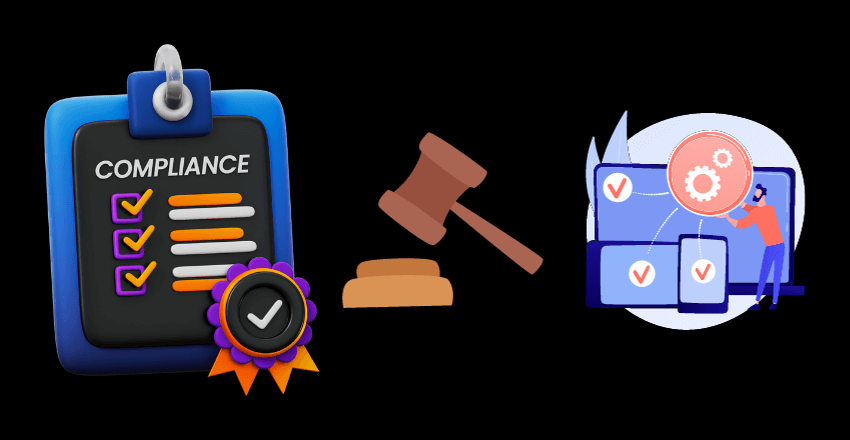 Compliance with Accessibility Laws in Cross-Platform Development is crucial for creating barrier-free digital environments, aligning with global standards to provide equal access and foster inclusivity in technology.
Compliance with Accessibility Laws in Cross-Platform Development is crucial for creating barrier-free digital environments, aligning with global standards to provide equal access and foster inclusivity in technology.
Ensuring accessibility compliance is a critical consideration for developers creating cross-platform applications. With the increasing reliance on digital technology, it is vital to prioritize inclusivity and equal access to technology for all users.
Key Takeaways:
- Developers must prioritize accessibility compliance to promote inclusivity and equal opportunities for all users.
- Key accessibility laws and standards include ADA compliance, WCAG standards, and Section 508 compliance.
- Mobile accessibility in cross-platform development requires specific considerations and challenges.
The Accessibility Laws and Standards
As a developer, it is essential to understand the different accessibility laws and standards that relate to web and digital accessibility. Ensuring compliance with accessibility laws such as the Americans with Disabilities Act (ADA) and Section 508 compliance is necessary to provide equal access to all users, regardless of their abilities.
Web Content Accessibility Guidelines (WCAG) is the most commonly used standard for web accessibility compliance. It provides a set of guidelines and success criteria for ensuring that websites and digital platforms are accessible to people with disabilities.
WCAG has three levels of compliance: A, AA, and AAA, with level AA being the most commonly used.
Section 508 compliance is a federal law that requires all electronic and information technology (EIT) developed, procured, maintained, or used by federal agencies to be accessible to people with disabilities. Section 508 covers a wide range of EIT, including websites, software, and hardware.
Another essential standard to consider is the Accessibility Guidelines for Building User Interfaces (ARIA). ARIA is a set of attributes that can be added to HTML to define the roles and properties of elements, allowing for more accessible designs.
Overall, understanding and implementing these accessibility laws and standards is vital to ensure that digital platforms and websites are accessible to all users, regardless of their abilities. By prioritizing accessibility compliance, developers can create inclusive designs that provide equal opportunities for people with disabilities.
The Role of Mobile Accessibility in Cross-Platform Development
Mobile accessibility is a critical consideration in cross-platform development to ensure that applications are available to everyone, regardless of their physical or cognitive abilities. Inclusive design principles can help developers create applications that are accessible to a wide range of users, including those with disabilities.
Understanding Inclusive Design
Inclusive design is an approach to creating products and services that consider the diversity of users and their needs. By designing for inclusivity, developers can create applications that are accessible to everyone, regardless of their physical or cognitive abilities.
Mobile devices have unique accessibility challenges, such as small screens and touch-based interfaces. Developers must take these challenges into account when designing cross-platform applications to ensure that they are accessible to everyone.
Ensuring Accessibility Compliance for Cross-Platform Development
Developers must consider accessibility compliance when creating cross-platform applications. Compliance with accessibility laws and standards, such as the Web Content Accessibility Guidelines (WCAG) and Section 508 compliance, is essential to ensure that applications are accessible to everyone.
Implementing accessibility features, such as alternative text for images and captions for videos, is also crucial for achieving accessibility compliance in cross-platform development. Additionally, developers must consider how their applications will be used across various mobile devices and platforms.
Best Practices for Mobile Accessibility in Cross-Platform Development
Developers can follow several best practices for ensuring mobile accessibility in cross-platform development:
- Use responsive design principles to adapt applications to various screen sizes and orientations
- Provide clear and simple navigation to enhance usability for users with cognitive impairments
- Ensure that text and interactive elements are large enough to be easily visible and clickable
- Consider the use of assistive technologies, such as screen readers and voice commands, to make applications accessible to users with visual or motor impairments
Mobile accessibility is an essential consideration in cross-platform development. Inclusive design principles, compliance with accessibility standards, and best practices for mobile accessibility can help developers create applications that are accessible to everyone, regardless of their abilities or the devices they use.
Accessibility in Cross-Platform Development

Ensuring accessibility in cross-platform development is vital to providing equal access to applications for all users. Achieving accessibility requires compliance with accessibility standards and cross-platform accessibility guidelines. Here are some strategies that developers can follow:
1. Adopting Inclusive Design Principles
Inclusive design is the practice of designing products and services that can be used by people with a diverse range of abilities. By adopting inclusive design principles in cross-platform development, developers can ensure that applications are accessible to everyone, regardless of their abilities or the device they are using.
2. Testing for Accessibility Compliance
Testing is a crucial part of ensuring accessibility in cross-platform development. Developers should test their applications for compliance with accessibility standards, such as WCAG, and ensure that they are accessible on different devices and platforms.
3. Providing Alternative Text for Images
Providing alternative text for images is an essential accessibility feature that allows users with visual impairments to understand the content of images. Developers should ensure that all images in their applications have alternative text that accurately describes the image.
4. Implementing ARIA Roles
ARIA roles are HTML attributes that allow developers to add additional information to web content, making it more accessible to users with disabilities. Developers should implement ARIA roles in their applications to provide additional information about the functionality of different elements in the interface.
5. Designing for Responsive Layouts
Responsive design is the practice of designing websites and applications that can adapt to different screen sizes, from desktops to mobile devices. By designing for responsive layouts, developers can ensure that their applications are accessible on different devices and platforms.
By following these strategies and complying with accessibility standards, developers can ensure that their applications are accessible to everyone, providing equal access and opportunities to all users.
The Connection between Cross-Platform Development and ADA Compliance
As a developer, it’s crucial to understand the importance of accessibility compliance in cross-platform development. With the Americans with Disabilities Act (ADA) in place, it’s become mandatory to ensure that your applications are accessible to people with disabilities.
This includes those who use assistive technology such as screen readers, voice recognition software, and alternate input devices.
It’s not only the legal requirements that make accessibility compliance essential in cross-platform development. By creating accessible applications, you’re promoting inclusivity and equal opportunities for everyone to use your product, regardless of their abilities or disabilities.
This will also improve your brand reputation and increase customer satisfaction.
The best way to ensure ADA compliance in cross-platform development is to prioritize accessibility from the very start of the design process. By making accessibility a part of your development philosophy, you can ensure that your applications are inclusive and accessible to everyone.
Not only do you need to consider ADA compliance, but you also need to ensure cross-platform accessibility in your development process. This means that your applications should be accessible on different devices and platforms, such as web browsers, mobile devices, and desktop applications.
By achieving cross-platform accessibility, you can provide a seamless experience for your users across various devices and make your application available to more users.
Overall, compliance with accessibility laws in cross-platform development is not just a legal requirement. It’s also an essential aspect of creating inclusive, accessible applications for everyone to use. By prioritizing accessibility in your development process, you can ensure that your applications are ADA compliant and accessible across platforms, benefiting your users and your brand reputation.
Implementing WCAG 2.0 and ARIA Roles in Cross-Platform Development
Ensuring accessibility in cross-platform development requires the use of specific guidelines and principles. WCAG 2.0 and ARIA roles are two essential tools for meeting accessibility standards in cross-platform development. Let’s dive into how these can be implemented:
WCAG 2.0 Guidelines
WCAG 2.0 guidelines are a set of standards for web content accessibility. These guidelines are divided into three levels – A, AA, and AAA – with each level specifying increasingly strict requirements for accessibility. Developers must ensure that their applications comply at least with the WCAG 2.0 Level A standards.
To implement WCAG 2.0 guidelines in cross-platform development, developers should follow the principles of perceivability, operability, understandability, and robustness. These principles provide a framework for creating accessible applications that can be used by people with diverse abilities and disabilities.
ARIA Roles
Accessible Rich Internet Applications (ARIA) roles are a set of attributes that can be added to HTML tags to improve the accessibility of web applications. ARIA roles can help in providing additional information to assistive technologies, such as screen readers, to properly interpret the content of an application.
The ARIA roles can be used in combination with other accessibility techniques, such as semantic HTML, to create accessible applications in cross-platform development. Developers should use ARIA roles to supplement the existing HTML markup and improve the accessibility of cross-platform applications.
Responsive Design
Is a crucial aspect of achieving cross-platform compliance with WCAG 2.0 and ARIA roles. Responsive design ensures that applications adapt to different devices and platforms, making them accessible to all users, regardless of their device or platform preferences.
Developers should use responsive design techniques, such as fluid layouts, flexible images, and media queries, to create applications that are optimized for multiple devices and platforms. With responsive design, developers can ensure that their applications meet WCAG 2.0 standards and incorporate ARIA roles while remaining accessible across different devices and platforms.
Cross-Platform Compliance
Implementing WCAG 2.0 guidelines and ARIA roles, along with responsive design, is crucial for achieving cross-platform compliance. Cross-platform compliance ensures that an application is accessible across different devices and platforms, providing equal access to all users.
Developers should test their applications on different devices and platforms to ensure cross-platform compliance with WCAG 2.0 and ARIA roles. Testing should include various assistive technologies, such as screen readers and voice recognition software, to ensure that the application can be used by people with different abilities and disabilities.
By implementing these techniques, developers can achieve accessibility in cross-platform development while complying with WCAG 2.0 standards and incorporating ARIA roles.
Website Accessibility and Cross-Platform Development
In cross-platform development, it is crucial to ensure website accessibility. Developers must comply with accessibility requirements to provide equal access to all users, regardless of any disabilities. This section will explore some of the specific considerations for website accessibility in cross-platform development.
Compliance Requirements
To achieve website accessibility in cross-platform development, developers must comply with certain standards and regulations. The Web Content Accessibility Guidelines (WCAG) are the most widely used standards for website accessibility.
WCAG 2.1 provides detailed guidelines for developers to ensure that websites are accessible to people with disabilities.
Section 508 of the Rehabilitation Act also outlines specific accessibility requirements for federal agencies and organizations that receive federal funding. Websites must meet certain accessibility standards to comply with Section 508.
Testing and Auditing Websites for Accessibility
It is important to test and audit websites for accessibility to ensure that they can be used by people with disabilities. Developers can use automated testing tools to check for accessibility issues and make necessary changes. Manual testing is also crucial to identifying any accessibility issues that automated tools may miss.
Regular auditing of websites for accessibility is also necessary to ensure that new content or updates do not introduce new accessibility barriers. Developers must stay up-to-date on any changes to accessibility guidelines and adjust their websites accordingly.
Strategies for Achieving Cross-Platform Accessibility
To achieve cross-platform accessibility, developers should focus on designing websites with responsive design principles. Primarily, responsive design allows websites to adapt to different screen sizes and ensures that content is presented in a user-friendly manner, regardless of the device or platform being used.
Additionally, developers can use ARIA roles to ensure that website content is accessible to assistive technology users. ARIA roles provide information to assistive technology about the purpose and function of different website elements.
Website accessibility is a critical consideration in cross-platform development. Importantly, developers must comply with accessibility requirements, test and audit websites for accessibility, and implement strategies to achieve cross-platform accessibility. By prioritizing website accessibility, developers can ensure that their applications are accessible to all users, providing equal access and opportunities.
Overcoming Challenges in Cross-Platform Accessibility

Developing applications that work seamlessly across multiple devices and platforms, while ensuring accessibility compliance, can be complex and challenging. This section addresses common challenges in achieving cross-platform accessibility. It also provides strategies and solutions to overcome them.
Design Limitations
A main challenge in cross-platform accessibility is the unique design limitations of different platforms and devices. Designs suitable for desktops may not work on mobile screens. To overcome this, developers should prioritize inclusive design principles. They should create layouts that are flexible and adaptable to various screen sizes and resolutions.
Technical Compatibility
Ensuring technical compatibility across different devices and platforms is another challenge. Developers should test their applications on various devices and platforms. They need to ensure full functionality and accessibility. Utilizing cross-platform accessibility frameworks and guidelines, like those from WCAG, helps ensure compatibility in design.
Lack of Awareness and Resources
A common challenge is the lack of awareness and resources. Some developers might not understand the importance of accessibility compliance. They may lack the resources or knowledge for effective implementation. To address this, developers can access training and resources on accessibility compliance and best practices. Collaborating with accessibility experts or getting feedback from users with disabilities ensures that applications are inclusive and accessible to all.
Wrapping Up

I cannot stress enough the importance of compliance with accessibility laws in cross-platform development. Significantly, creating inclusive applications that cater to all users is not only a legal requirement but also a moral obligation for developers. By ensuring cross-platform accessibility, we can empower people with disabilities to access digital content and services on equal terms.
Furthermore, developers must be familiar with key accessibility laws and standards, including the ADA, WCAG, and Section 508 compliance. They also need to consider mobile accessibility and implement strategies to achieve accessibility in cross-platform development. This process includes using responsive design, ARIA roles, and WCAG 2.0 guidelines.
Moreover, testing and auditing websites and applications for accessibility compliance is crucial in ensuring cross-platform accessibility. Although there may be challenges in achieving cross-platform accessibility, developers can overcome them by following cross-platform accessibility guidelines.
As we move towards an increasingly digital world, it is vital that accessibility remains at the forefront of our development efforts. By prioritizing compliance with accessibility laws in cross-platform development, we can create a more inclusive and accessible society for all.
External Resources
https://developer.mozilla.org/en-US/docs/Learn/Accessibility/WAI-ARIA_basics
https://www.w3.org/WAI/standards-guidelines/wcag/
FAQ

What is the importance of compliance with accessibility laws in cross-platform development?
Compliance with accessibility laws ensures that applications are inclusive and provide equal opportunities for all users, including those with disabilities. It promotes accessibility and inclusivity in the digital space.
What are some key accessibility laws and standards that developers need to be aware of?
Developers should be aware of laws such as the Americans with Disabilities Act (ADA) and compliance standards such as the Web Content Accessibility Guidelines (WCAG) and Section 508. These provide guidelines for ensuring accessibility in digital platforms.
What are the specific considerations and challenges related to mobile accessibility in cross-platform development?
Mobile accessibility in cross-platform development involves designing applications that are accessible and user-friendly across different devices and platforms. It requires considering factors such as screen sizes, touch targets, and assistive technologies.
What are some practical strategies and techniques for ensuring accessibility in cross-platform development?
Best practices for achieving accessibility in cross-platform development include following compliance requirements, adhering to cross-platform accessibility guidelines, and conducting thorough testing and auditing. Designing with accessibility in mind from the beginning is also crucial.
How does cross-platform development connect to ADA compliance?
Cross-platform development must comply with accessibility laws, such as the ADA, to provide equal access to all users. Accessibility is a fundamental requirement in cross-platform development to ensure inclusive experiences for individuals with disabilities.
How can WCAG 2.0 and ARIA roles be implemented in cross-platform development?
WCAG 2.0 guidelines and ARIA roles can be implemented by incorporating responsive design principles, using appropriate HTML tags, and providing alternative text for images. These measures enhance the accessibility of applications across different platforms.
What considerations are important for website accessibility in cross-platform development?
Website accessibility in cross-platform development involves meeting compliance requirements, conducting regular accessibility testing, and incorporating features that allow users to navigate and interact with the website seamlessly across different platforms.
What are the common challenges in achieving cross-platform accessibility?
Challenges in achieving cross-platform accessibility include handling platform-specific functionalities, maintaining consistent user experiences, and addressing device variations. Developers need to find solutions to these challenges to ensure accessibility across platforms.
What is the importance of compliance with accessibility laws in cross-platform development?
Charlotte Williams is a talented technical author specializing in cross-platform app development. With a diverse professional background, she has gained valuable experience at renowned companies such as Alibaba and Accenture. Charlotte’s journey in the tech industry began as a mobile UX designer back in 2007, allowing her to develop a keen understanding of user-centric app design.
Proficient in utilizing frameworks like React Native and Flutter, Charlotte excels in building cross-platform mobile apps and imparting her knowledge to aspiring developers. She pursued a degree in Computer Science at Cornell University, equipping her with a strong foundation in the field. Residing in San Francisco with her three beloved dogs, she finds solace in hiking the hills and connecting with nature. Charlotte’s passion for app development, combined with her dedication to sharing expertise, makes her an invaluable resource in the world of cross-platform app development.







